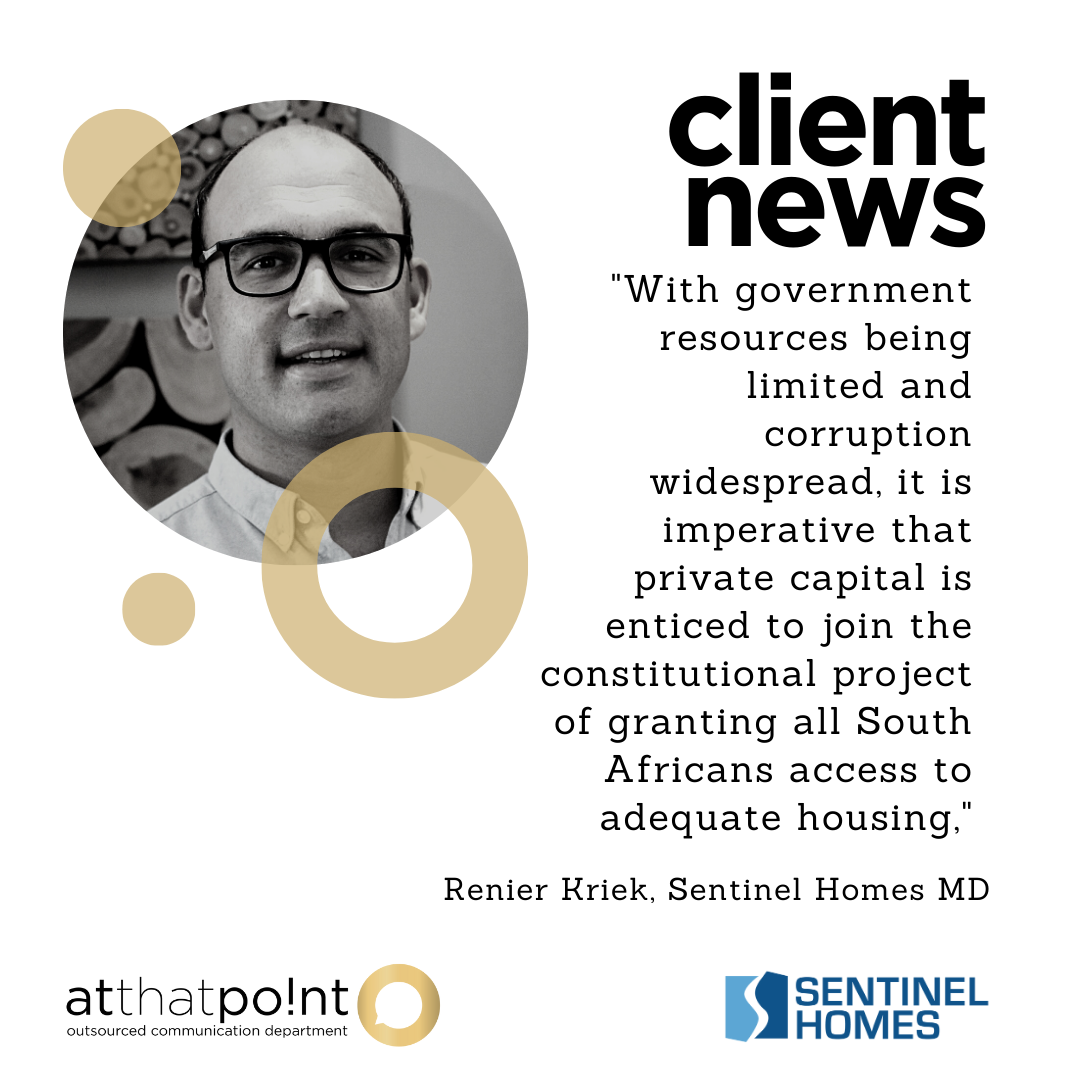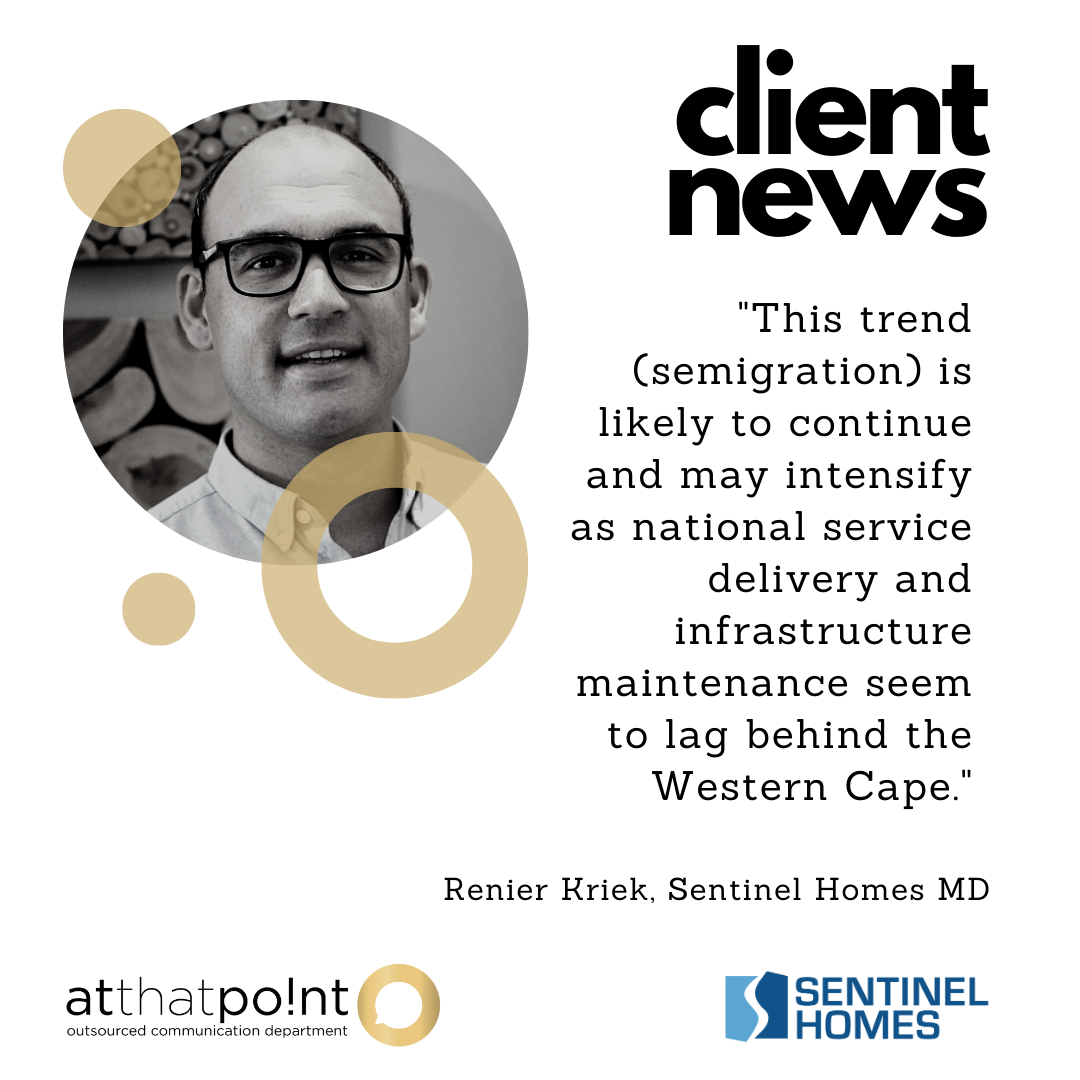 This year, almost half of the world's inhabitants will head to the polls to elect their new governments, including 8 of the world’s 10 most populous countries. "In South Africa, we can expect our own election to put the property market into a temporary holding pattern, dragging on the subtle buyer’s market we have been experiencing" says Renier Kriek, Managing Director at Sentinel Homes. While he advises owners to wait until the end of the year to consider selling their property, Kriek cautions buyers to not get caught up in election fears and miss out on real estate bargains. The impact of sentiment All market behaviours are driven by sentiment. South Africans face uncertainty around the outcome of the election and the likelihood that, for the first time in its history, the country will be led by a coalition government at the national level. This creates negative sentiment that is also being fuelled by the heightened and increasingly populist rhetoric of competing political parties. And persistent factors, like the delay in interest rate cuts and a declining rand, only add to the doubt. "While we were all hoping for a downturn in the rate cycle at SARB's May or July meeting, I now doubt anything will happen before September. The MPC remains hawkish and seem unlikely to move interest rates down before the US Federal Reserve has lowered their policy rate," says Kriek. That's expected well after the election and these compounded concerns are pushing people to take a wait-and-see approach, including in the buying and selling of property. A first for South Africa All countries with a proportional representation electoral system eventually face a coalition government scenario. The likelihood of a national governing coalition is therefore a sign that our political system is maturing. This will be South Africa's first coalition government at a national level and the norms associated with such a structure have never been firmly established among the political class or the voting population. While national coalitions are a sign of progress and maturity, it is likely to lead to a lot of short- to medium-term noise, that is likely to have a continuing and unpredictable impact on sentiment in all markets, including the property market. The nearest we have to some agreement is the Multiparty Charter whose only purpose is to counter a national coalition between the ANC and EFF. Countries like Belgium with older proportional representation systems have developed the advanced bureaucracy necessary to almost run the country on autopilot, even without a government. South Africa, however, still needs to find its footing in any coalition pacts and develop the necessary protocols among participants intent on promoting their own interests. "This means things will probably be noisy and messy for some time after the election, as parties attempt to nail down the terms of their respective alliances," says Kriek. What to expect from property Currently, it's still a buyer's market for property and it definitely won't turn into a seller's market until after the election and a rate cut. Until then, we can expect that property price growth will remain low. Once the election outcome is known, and provided we have avoided worst-case scenarios, and the rate cut is at hand, we can expect pent-up demand for property to spill into the market and significantly increase demand. In addition, weak economic growth means sellers who can afford to wait should indeed wait until spring or summer to see if they can fetch a good price for their property relative to the market. Winter is historically not a great time for selling homes anyway. Despite the general modd brought on by politics and the interest rate cycle, the market in the Western Cape remains buoyant and there are signs of buyers returning in earnest to areas like southern Gauteng and areas eastof Pretoria. The smart money of property investors also remains in the market, signalling that opportunities exist. Along with low property price growth, this means that astute buyers can still pick up bargains while others hesitate. "If you want to buy, buy now and don't be put off by sentiment-driven hesitance that currently prevails in the market election sentiment," advises Kriek. “In the South African property property market, due to structural factors, what goes down must eventually come up.” ENDS MEDIA CONTACT: Rosa-Mari Le Roux, [email protected], 060 995 6277, www.atthatpoint.co.za For more information on Sentinel Homes please visit: Website: www.sentinelhomes.co.za Facebook: Sentinel Homes
0 Comments
 There is a major surge in investment in buy-to-let properties across South Africa, with the Western Cape leading the pack. "We're seeing a 15 year high in national investment applications, which rose to 11.8 percent of all applications by the last quarter of 2023," says Renier Kriek, Managing Director at Sentinel Homes, who bought his first investment property at 19 and has been investing in residential property ever since. Usually, this figure is around 5 percent. Kriek is quoting recent ooba Home Loans market data which also puts investment applications in the Western Cape at a whopping 28.2 percent of total applications. "The housing demand in the province is enormous and property investors are obviously taking note," says Kriek. Investors, not home buyers Home buyers are hesitant to buy right now due to uncertainty around the upcoming election, as well as the rising cost of living caused by inflation and high interest rates. This could mean current data may be skewed by their lower participation, making investment applications appear greater as a percentage. Even so, it also indicates that property investors remain confident, active in the market, and resilient regardless of economic pressures. Property investment may also be seen as more secure in the current uncertain political climate. Why is property investment vibrant? One reason is the ongoing trend of semigration, with South Africans flocking to areas offering better infrastructure and service delivery. This is especially true of the Western Cape where new property development lags the influx of semigrants. Many coming to the province now rent while searching for a new home or while theirs is being built. Another reason is the return of tourists to Cape Town, still one of the top holiday destinations in the world. Investors are already snapping up prime properties they can rent out as short-term leases and holiday accommodations. The increased demand for rentals and improving performance in rental properties, including lower vacancies and tenant defaults, is driving the wave of buy-to-let investment applications. Tips for investors So, if people are serious about investment buying, does Sentinel Homes have any tips for them? "Indeed, we do," says Kriek.
New and experienced investors alike can benefit from Krieks advice. ENDS MEDIA CONTACT: Idele Prinsloo, [email protected], 082 573 9219, www.atthatpoint.co.za For more information on Sentinel Homes please visit: Website: www.sentinelhomes.co.za Facebook: Sentinel Home  Overregulation of the housing market in South Africa is discouraging the private sector from investing in formal low-cost housing projects. This is according to Renier Kriek, Managing Director at Sentinel Homes. "With government resources being limited and corruption widespread, it is imperative that private capital is enticed to join the constitutional project of granting all South Africans access to adequate housing," he says. It is apparent that, for all the government's initiatives, programmes and subsidies to provide RDP housing, a vast number of underprivileged citizens still reside in informal settlements. However, while tax breaks exist for new or improved rental housing, with added incentives for low-cost housing, the rest of the legal and policy landscape is much less persuasive to investors. Mortgage risk For one, housing consumers who earn less than R15,000.00 per month make up less than 0.6 percent in value and 1.7 percent in number of accounts granted mortgages in Q1 2023, matching a decade long trend. This is because banks tend to avoid these riskier applicants, even when supported by the government's Finance-Linked Subsidy Programme (FLISP). The reason is simple: the excessively long and inefficient foreclosure process in South Africa seems bent on ensuring losses for both banks and defaulting consumers. In addition, judges are often overly sympathetic to defaulting debtors per case, not considering the overall negative effect this has on banks' attitude towards financing the larger underprivileged community. "However, if the cost of terminating defaulting mortgages were low, banks would be less risk averse, thereby increasing the likelihood of access by this segment," says Kriek. Rental risk Similar to mortgages, the time and financial costs of eviction are too high, and the law and courts too lenient on defaulting renters. With the supply of formal housing being so low, the cost of eviction should also be low and the rights of a large number of potential tenants should weigh more heavily than those of a few non-paying tenants. "If the risk was low, more landlords would emerge to invest in satisfying the obvious demand for affordable accommodation," says Kriek. Development rules Lastly, housing development in South Africa is inhibited by long or delayed regulatory processes, as well as building standards designed around first-world circumstances. This is further exacerbated by municipal inefficiency, which affects delivery of essential services like roads, water, power and sanitation. Authorities have also suddenly become deeply concerned with the lack of affordable housing. Their response has been to request that developers include affordable housing units in new developments, even in areas not marked for such housing. "While laudable at first glance, this does not increase the availability of affordable housing as beneficiaries will often flip the unit at market price to realise a profit," says Kriek. The positive intent is therefore negated and leaves the market worse off. Change Is Needed Mortgage risk, rental risk and misguided development rules, taken together, disincentivise the development of low-cost housing in favour of larger, pricier units. "Given the state of the country’s housing market, urgent legal reforms and business-friendly policies are needed to ensure all South Africans gain access to constitutionally mandated housing," says Kriek. ENDS MEDIA CONTACT: Rosa-Mari Le Roux, [email protected], 060 995 6277, www.atthatpoint.co.za For more information on Sentinel Homes please visit: Website: www.sentinelhomes.co.za Facebook: Sentinel Home  Homes farther out, and more reasonably priced. This is increasingly what South African property buyers are looking for. “There are multiple reasons contributing to this trend,” explains Renier Kriek, CEO of home financing company Sentinel Homes. "Rising interest rates and the resulting decline in transaction volume are significant factors. The increased proportion of ‘motivated sellers,’ selling because they are in a rising costs squeeze, are now likely to stabilise price growth until the rate hiking cycle eases off or starts to reverse.” According to Kriek, the consequences of the Covid-19 pandemic are also still very visible. “Office vacancy rates have increased, resulting in consumers no longer being as motivated by office proximity when selecting homes. This means they can search for value in outlying areas. Many even semigrate to other parts of the country. We also expect to see a rising level of commercial to residential conversions in urban areas. Semigration and its cousin convenience Kriek names the current hottest markets and sites for real estate investment as the coastal regions from the West Coast to Cape Town and Mossel Bay. “The Mother City remains very popular despite high prices and strained infrastructure,” he says. “This thanks to their loadshedding buffer due to the City’s generation projects and other electricity initiatives, as well as the city’s lifestyle benefits.” He claims that the Garden Route and George Airport’s close proximity make this popular tourist destination just as convenient as Cape Town. “But it must be highlighted that the affordability benefit there is quickly waning because this area has become a focus for immigrants from both inside and outside the Western Cape.” Finally, the West Coast (north of Cape Town) is also seeing a rise in the real estate market, thanks to its charming tiny fishing villages and rural communities like Langebaan, St Helena Bay and Paternoster. “Consumers who work from home are discovering the real value in pricing that was previously only influenced by variables connected to the regional fishing and farming industry. Due to external demand for property, it is now unbound. On the other hand, gentrification problems may result from this and increasingly poor access to housing for families in the bottom half of the income spectrum is a real threat.” Kriek says those still buying property in the economic hub of Gauteng, are shying away from freehold properties, such as single houses on larger plots in unguarded neighborhoods. “They prefer estates and sectional schemes. This is likely a search for safety and services,” he elaborates. Those entering the Gauteng property market will likely find the best long-term investment to be inside a security estate or secured sectional title scheme. Owners of freehold properties in more traditional suburbs may consider cashing out and moving with the trend in the interest of their longer-term financial well-being.” Challenges for First Time Buyers Kriek says that first-time buyers - who make up a very large proportion of purchasers - are moving into the property market much later. This trend is continuing to intensify. The lack of affordable housing supply and inefficient housing finance market in the affordable or gap housing market, specifically properties priced under R750 000, contributes significantly to this trend. “The National government, through the Department of Human Settlements, unveiled significant updates to their Finance Linked Individual Subsidy Programme (FLISP), now called First Home Finance, with the aim to improve access to affordable and gap housing. The expanded policy is still in the nascent stage of implementation, however, and its effects are likely not to be evident in market trends until next year.” Kriek adds that Sentinel Homes offers the first open-market alternative to mortgages. By expanding access to housing finance, it is serving those 5%-10% of housing consumers who lack housing finance, despite being creditworthy and having the necessary disposable income. “Now is the time in the property market cycle to escape the rent trap and start meaningful steps toward long-term financial health. Homeownership is a significant part of that equation,” says Kriek. “You are more likely to buy something you can really afford if you buy it in the current conditions. There is the added upside that prices for properties priced around the average can only really go one way from here – and that is up!” ENDS MEDIA CONTACT: Rosa-Mari Le Roux, [email protected], 060 995 6277, www.atthatpoint.co.za For more information on Sentinel Homes please visit: Website: www.sentinelhomes.co.za Facebook: Sentinel Homes  While some people have emigrated to other countries to escape South Africa's apparent socio-economic decline, those who opt to stay may simply ‘semigrate’ to better provinces or areas. Gauteng, with Johannesburg and Pretoria, remains the country’s economic powerhouse. Despite being the smallest province, it hosts almost 1 in 4 South Africans. It also contributes more than a third of GDP (Stats SA 2017) and more than 40% of consumer credit is granted within its borders (National Credit Regulator Q4 2022). However, there has long been a trend of South Africans seeking out perceived lifestyle advantages by moving to other provinces. “KZN and, most notably, the Western Cape are favoured semigration destinations,” says national property trends expert and co-founder of Sentinel Homes, Renier Kriek. Increased semigration Before Covid-19, semigration often took one of two forms. Firstly, whole businesses or business units would relocate to the Western Cape or KZN with their employees in tow. This practice continues as businesses seek better service delivery, such as the City of Cape Town’s ability to shield its residents and businesses from some of the effects of load shedding. The second form was people who quit their jobs and accepted a pay cut to enjoy the so-called ‘lifestyle dividend’ of living closer to the shore or in rural areas, or decided to move their families and commute to Gauteng by plane, to arrive at the same result. After Covid-19, which normalised remote working, a third variant of the semigration trend arose. Remote workers can now work from almost anywhere. “This new development has led to increased semigration to outlying or previously less favoured areas, such as small coastal towns, where whole businesses and single job-seekers would rarely have ventured,” says Kriek. These include West Coast towns such as Langebaan, St Helena Bay and Paternoster. The sleepy fishing village of St Helena Bay, for example, has 23 real estate agencies at last count, each with a number of agents selling and renting out property. The market for real estate there is booming. Factors driving people to such destinations include the desire to escape higher levels of load shedding and crime, improved service delivery, a more relaxed social environment, and promising economic growth, job creation and infrastructure development. In-demand areas For lower income consumers, the Western Cape is attractive due to its lower unemployment rate (21.6% vs 32.9% nationally). The province is also reducing unemployment faster than other parts of the country. In addition, it has an advantage in infrastructure, such as schools and hospitals, which are perceived to be superior. Between February 2022 and February 2023, food prices in the Western Cape grew by 12.4%, which is much lower than Gauteng (14.2%). “The semigration trend in the Western Cape is fairly broad-based whereas the northern coast is attracting more affluent earners from Gauteng,” says Kriek. Similarly, unemployment in KZN (30.9%) and the Northern Cape (26.6%) is less than the national average. Impact of semigration While some areas are feeling the impact of semigration, others are witnessing economic growth as a result of this influx of new residents. On the one hand, previously popular locations like the northern suburbs of Cape Town have become much busier due to semigration, with the roadways surrounding the city showing signs of being overburdened. However, other favourite semigration destinations, like Mossel Bay, are enjoying beneficial growth and urbanisation. In Mossel Bay's case, this is due to its close proximity to George Airport, which makes commuting between Johannesburg and Cape Town's suburbs easy and convenient. It is also highly probable that the flood of semigrants to these areas could drive housing prices up. This could be either to the benefit of locals selling their property or to their detriment if they wish to buy. In addition, existing homeowners could face higher-than-normal rates increases. Prices in the Cape Town metro area have already far outpaced growth in the other urban centres. This factor, coupled with the inclination to seek greater value in times of rising interest rates, is driving buyers to hunt for property in outlying areas that could yield bigger bang for their buck. “This trend is likely to continue and may intensify as national service delivery and infrastructure maintenance seem to lag behind the Western Cape,” says Kriek. Availability of property The supply of property may be hampered by over regulation of new constructions while reducing the availability of affordable housing to lower income earners. As demand outstrips supply, areas outside established urban and suburban districts will surely gain more attention from home seekers, and experience the same economic benefits and growth. Kriek says that prospective semigrants should therefore take the plunge as soon as possible. "There are other trends to consider apart from semigration when deciding where to live so it's important to plan carefully; in addition, interest rates are already peaking so, if you can afford it, you will likely be better off in the future as long as you act now," he says. ENDS MEDIA CONTACT: Rosa-Mari Le Roux, [email protected], 060 995 6277, www.atthatpoint.co.za For more information on Sentinel Homes please visit: Website: www.sentinelhomes.co.za Facebook: Sentinel Homes |
Welcome to the Sentinel Homes Newsroom. BROADCAST INTERVIEWS2023 Archives
July 2024
Categories
All
|

 RSS Feed
RSS Feed